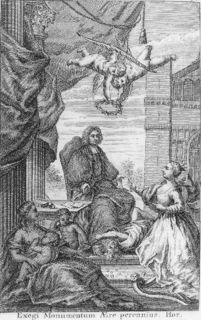
Drapier's Letters is the collective name for a series of seven pamphlets written between 1724 and 1725 by the Dean of St Patrick's Cathedral in Dublin, Jonathan Swift, to arouse public opinion in Ireland against the imposition of a privately minted copper coinage that Swift believed to be of inferior quality. William Wood was granted letters patent to mint the coin, and Swift saw the licensing of the patent as corrupt. In response, Swift represented Ireland as constitutionally and financially independent of Britain in the Drapier's Letters. Since the subject was politically sensitive, Swift wrote under the pseudonym M. B., Drapier, to hide from retaliation.

Laetitia Pilkington was an Anglo-Irish poet. She is known for her Memoirs which document much of what is known about Jonathan Swift.
James Worsdale was an Irish and English portrait painter, actor, literary fraud, and libertine whose lively conversation, wit, and boldness allowed him to move among the highest circles of literary life. His skills as a painter are not widely praised by art historians, but his confidence and assertiveness secured him numerous commissions for portraits.
Josiah Hort, was an English clergyman of the Church of Ireland who ended his career as archbishop of Tuam.

Alan Brodrick, 1st Viscount Midleton, PC (Ire) was a leading Irish lawyer and politician who sat in the Parliament of Ireland between 1692 and 1715 and in the British House of Commons from 1717 to 1728. He was Speaker of the Irish House of Commons and Lord Chancellor of Ireland. Although he was a man of great gifts, he was so hot-tempered that even Jonathan Swift is said to have been afraid of him.
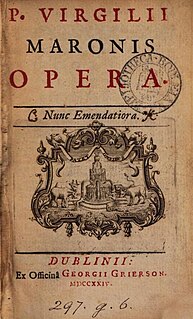
Constantia Grierson [née Crawley], was an editor, poet, and classical scholar from County Kilkenny, Ireland. She is notable for her achievements as a classicist, which were all the more remarkable given her labouring-class background.
Elizabeth Sican was an Irish literary critic. She was part of Jonathan Swift's "triumfeminate," along with Mary Barber and Constantia Grierson.

George Faulkner was one of the most important Irish publishers and booksellers. He forged a publishing relationship with Jonathan Swift and parlayed that fame into an extensive trade. He was also deeply involved with the argument over copyright infringement and piracy, both creating and fighting "Irish editions."
Motte v Faulkner was a copyright lawsuit between Benjamin Motte and George Faulkner over who had the legal rights to publish the works of Jonathan Swift in London. This trial was one of the first to test the Statute of Anne copyright law in regards to Irish publishing independence. Although neither held the copyright to all of Swift's works, the suit became a legal struggle over Irish rights, which were eventually denied by the English courts. Faulkner, in 1735, published the Works of Jonathan Swift in Dublin. However, a few of the works were under Motte's copyright within the Kingdom of Great Britain, and when Faulkner sought to sell his book in London, Motte issued a formal complaint to Jonathan Swift and then proceeded to sue Faulkner. An injunction was issued in Motte's favor, and the book was prohibited from being sold on British soil. The basis of the law protected the rights of the author, and not the publisher, of the works, and Swift was unwilling to support a lawsuit against Faulkner. With Swift's reaction used as a basis, the lawsuit was later seen as a struggle between the rights of Irishmen to print material that were denied under English law.

Quadrille is a card game that was highly popular in the 17th and 18th centuries at the French court and among the British nobility, especially women. A variant of the three-player, Spanish card game Ombre, it is played by four players, both in varying alliances and solo games, using a pack of 40 cards. By the mid-19th century, Quadrille had fallen out of fashion, superseded by Whist and Boston.
Matthew Pilkington (1701–1774), Church of Ireland priest, writer, and art historian, was the author of a standard text on painters that became known as Pilkington's Dictionary. His first wife was the poet and memoirist Laetitia Pilkington and their second son was the singer and writer John Carteret Pilkington.
This is a list of lawyers who held the rank of serjeant-at-law at the Irish Bar.
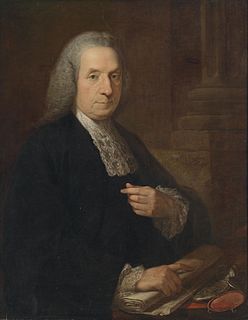
Philip Tisdall SL was an Irish lawyer and politician, who held the office of Attorney-General for Ireland. He was for many years a leading figure in the Irish Government.
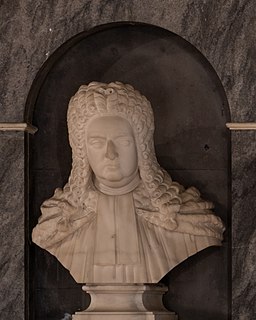
Henry Singleton (1682–1759) was an Irish politician and judge, who is remembered now mainly for his friendship with Jonathan Swift, and for his notable acts of charity during the Great Irish Famine of 1740-1, in which between 300,000 and 500,000 people died. Singleton House, his impressive townhouse in Drogheda, no longer exists.
Sir Richard Ryves (1643–1693) was a seventeenth-century Irish judge who served for several years as Recorder of Dublin, and subsequently as a Baron of the Exchequer.
Sir John Meade, 1st Baronet (1642–1707) was an Irish barrister, judge and politician. He was the first of the Meade Baronets of Balintubber, and an ancestor of the Earls of Clanwilliam. He was unusual among the lawyers of his time for his lack of ambition to become a judge of the High Court, despite being generally regarded as a barrister of "excellent parts (qualities)". In matters of religion, he seems to have been, by the standards of his time, a man of very tolerant views: although he was himself a Protestant, he damaged his career by marrying Elizabeth Butler, who was a Roman Catholic, as his third wife.
Robert Saunders (c.1650–1708) was an Irish landowner, barrister and politician. He sat in the Irish House of Commons as MP for Cavan, and was the Irish Prime Serjeant-at-law. Unusually, his youngest son, Morley Saunders, also held the office of Prime Serjeant. Robert was one of the founders of the village of Swanlinbar, County Cavan, which is partially named after him, according to Jonathan Swift, who states that "an" represents the "aund" in "Saunders".
Belcamp Park is a public park in Clonshaugh, Dublin 17, within the broad Coolock area, near Darndale and Priorswood. The park runs south of the N32, along the northern boundary of the city. It is owned by Dublin City Council and operated by the Council's Parks and Landscape Division.
Sir John Lyndon was an Irish judge and politician of the seventeenth century. He was the first holder of the office of Third Serjeant-at-law, which was created especially for him, apparently as a "consolation prize" for not being made a High Court judge the first time he sought that office.
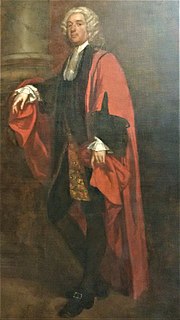
Eaton Stannard (1685–1755) was a leading politician and lawyer in eighteenth-century Ireland. He was a popular Recorder of Dublin, a very unpopular serjeant-at-law (Ireland), and an experienced parliamentarian who represented Midleton in the Irish House of Commons for many years. He is mainly remembered now as a close friend of Jonathan Swift, whose last known letter was written to him.










